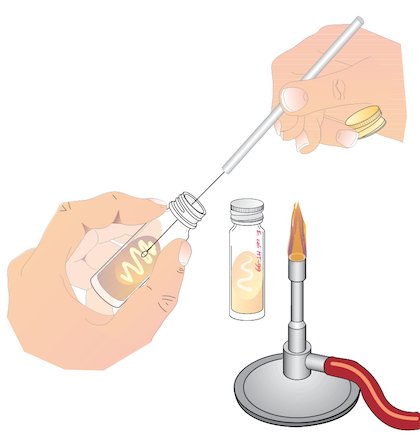Slope cultures

The NCBE supplies a range of microbial slope cultures that have special uses in education.
Safety advice: Working with microbes
Microbial culture information sheet
Practical protocol
BACTERIA
Bacillus subtilis
This Gram-positive species produces a variety of extra-cellular enzymes (amylase, lipase and cellulase) which can be detected using an appropriate growth medium and test (i.e., starch agar, which is flooded with iodine in potassium iodide solution after growth; tributryn agar — clear zones show lipase activity or CMC agar stained with dilute Congo Red solution). It is susceptible to streptomycin. Grow on nutrient agar or broth (in broth, it will produce a pellicle on the surface of the liquid).
Cellulomonas sp.
This strain produces extra-cellular cellulase. Grow on CMC agar or on nutrient agar onto which a disc of sterile Whatman No. 1 filter paper has been placed, or on CMC agar which can later be flooded with dilute Congo Red solution to reveal zones where the cellulose has been broken down.
Escherichia coli K-12 Strain DH10B
Gram-negative. Streptomycin resistant. Used in the NCBE’s bacterial transformation kit. Grow on nutrient or LB agar. This cloning strain must be incubated at 37 °C for good growth.
Escherichia coli Lac + (actually K-12 Strain J53-R)
Gram-negative. Produces β-galactosidase when lactose is present in the growth medium. Grow on nutrient or LB agar.
Escherichia coli Lac – (actually K-12 Strain TG2)
Gram-negative. Does not produce β-galactosidase in the presence of lactose. Grow on nutrient or LB agar.
Escherichia coli K-12 Strain J53-R
Gram-negative. Grow on nutrient or LB agar. J-53R carries on its chromosome a gene conferring resistance to the antibiotic rifampicin. Together with HT-99, it can be used to demonstrate bacterial conjugation [in this case, showing one way in which antibiotic resistance spreads].
Escherichia coli Strain HT-99
Gram-negative. Grow on nutrient or LB agar. E. coli HT-99 harbours a plasmid that includes a gene conferring resistance to the antibiotic chloramphenicol. Together with J53-R, it can be used to demonstrate bacterial conjugation [in this case, showing one way in which antibiotic resistance spreads].
Escherichia coli B Strain
Gram-negative. Susceptible to infection by T4 bacteriophage. Grow on nutrient or LB agar.
Janthinobacterium lividum
Produces a dark purple pigment (violacein) when the density of the cells is sufficient or other Gram-negative species are present (an example of quorum sensing). Grow on glucose nutrient agar or broth at 20 °C. Needs frequent subculturing.
Micrococcus luteus
Produces small bright yellow colonies. Can be used to test the effects of disinfectants, mouthwashes, toothpastes etc on microorganisms. Susceptible to streptomycin. Grow on nutrient agar or broth. Note: can be mixed with M. roseus then plated out to show how individual species can be obtained from a mixed culture.
Micrococcus roseus
Produces small vivid orange colonies. Susceptible to streptomycin. Grow on nutrient agar or broth. Note: can be mixed with M. luteus then plated out to show how individual species can be obtained from a mixed culture. Also a suitable ‘model organism’ against which antimicrobials such as disinfectants can be tested).
Pectobacterium carotovorum (= Erwinia carotovora)
This Gram negative bacterium produces pectinase and is responsible for soft rot of crops such as potatoes (its name means ‘carrot eater’). It is useful for the study of Koch’s postulates. Grow on nutrient agar. Also produces extra-cellular lipase, making opalescent zones on egg yolk agar.
Streptomyces griseus
Responsible for the earthy odour of soil (which can be smelt particularly after rainfall). This strain of S. griseus produces streptomycin (not all do). It has an unusual growth form, with a fungus-like, branching mycelium and aerial hyphae bearing conidia. Grow on glucose or glucose nutrient agar (nutrient agar with 1% glucose added).
Vibrio natrigens (=Beneckea natrigens)
This fast-growing marine bacterium was first isolated from a salt marsh in 1961. V. natrigens is often used for studies of growth, as it has the fastest known doubling time of any organism (9.8 minutes when grown at 37 °C with vigorous shaking in Heart-Brain infusion medium). Grow on nutrient agar with added salt (2% NaCl w/v).
FUNGI
Kluyveromyces lactis
A dairy yeast that produces lactase (β-galactosidase). Grow on malt agar or glucose nutrient agar.
Neurospora crassa
Red bread mould. Commonly used for genetics and growth experiments. Keep in the fridge to restrict its growth, and keep the slope culture inside a tightly-sealed plastic bag to prevent the spores from contaminating your fridge. Grow on glucose nutrient agar or potato starch agar. Note: there is a risk of allergy/asthma if large numbers of spores are inhaled.
Pichia anomala
This yeast produces a fragrant ester (see link to protocol above left). Grow on GYEP (glucose, yeast extract, peptone) broth or agar. Pichia anomala has redox enzymes on its outer membrane and can produce current in a mediator-less microbial fuel cell (i.e., a cell without methylene blue), as it donates electrons directly to the electrode.
Saccharomyces cerevisiae Strain K5-5A
An unusual strain that is dark red in aerobic conditions but white in anaerobic ones. Grow on malt agar or glucose nutrient agar.
Saccharomyces carlsbergensis
Probably the best yeast in the world… Grow on malt agar or glucose nutrient agar. Useful for demonstrating how different species can metabolise different sugars (S. carlsbergensis can use raffinose for anaerobic fermentation while baker’s yeast, S. cerevisiae, cannot).
Saccharomyces diastaticus
Makes AMG (amyloglucosidase, also known as glucoamylase). Grow on malt agar or nutrient agar plus 1% starch.
VIRUS
T4 bacteriophage
Use with the B strain of E. coli.
Bacteriophage 450 uL liquid culture….currently unavailable
SLOPE CULTURES
All slope cultures ….. £17.00 (GBP) each.
ORDERING
All of the prices on this page are in GBP and do not include Value Added Tax (VAT). This tax applies within the European Union only. Postage and handling must also be paid on orders from outside the United Kingdom. Details of how to order are given on the price list and on the Ordering web page.

